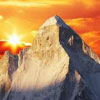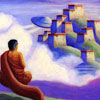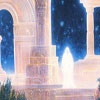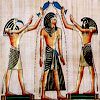Spacemen In Old Tibet
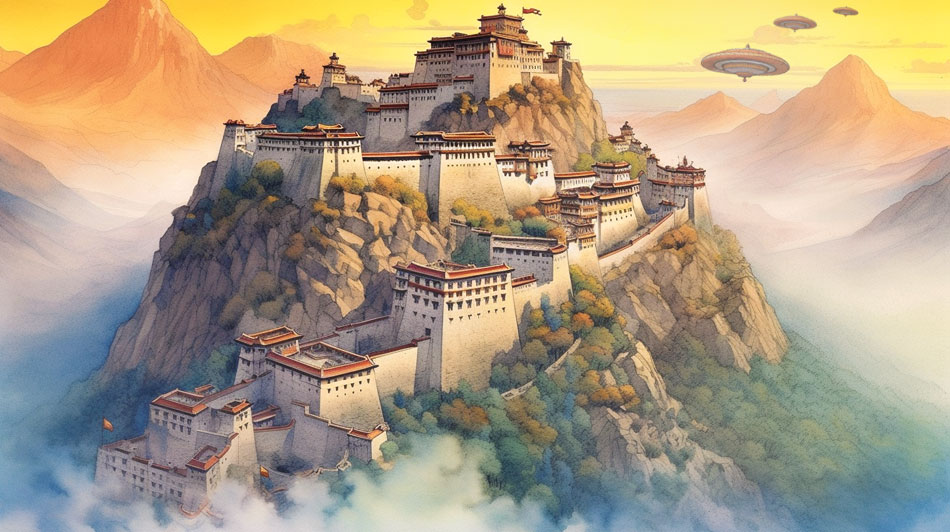 by W. Raymond Drake
by W. Raymond Drake
The glorious Sun enchanted the Earth to splendor inspiring the Giants with the joy of life, the thrill of basking in the beauty of this wonderful world, living almost forever like the golden Sky Gods. Sunbeams danced on the wavelets washing this Tibetan shore and caressed the crowds sporting on the beach; children played and splashed in the sea pausing to stare wide-eyed as a gleaming vimana glided down towards the gilded towers of Lhasa, the Celestial City, whose translucent temples and flowery parks reminded the Venusians of their own fair planet. Young lovers frolicked in joyous abandonment to music conjured from the air; some gazed mutely at their mates lost in love’s sweet mystery, while their friends gaily prattled of holidays in the forests at the South Pole, climbing those snow-capped mountains of Atlantis, or even tripping to Proserpine, the newly discovered planet beyond Pluto, whose alluring witches promised tempting delights. Women in exotic gowns, which matched their moods, flaunted a beauty of body and soul; in feminine glee they gossiped about the latest scandal intriguing the gay Tibetans. Talor, the young High Priest, whose fantastic but wayward genius amazed even the renowned scientists of that Asiatic island, had materialized from etherean realms a blond maiden whom he meant to marry. The ladies protested in indignation, brides from the stars might be welcome perhaps but a demoness from the astral world surely offered unfair competition, especially if her face was really fairer than the Sun, her eyes more magic than the Moon; her vivacious charms were seducing the virile High Priest, perversely immune to all the Beauties in Tibet. Some ladies defended the gallant. After milennia of peace, men were bored; space no longer thrilled; one planet seemed like any other; telepathy with the animals proved disappointing; even sex was losing its savor; this demoness brought new ideas; her strange, exciting revelations of the etherean world would revolutionize life on Earth, the future, shone with promise.
On a rock nearby, some blond Giants sat listening to Yellus the psycho-scientist, whose bronze features showed concern unusual for the cheery Tibetans. He was explaining that astronomers on Saturn had detected a celestial body approaching the Solar System; observers believed the intruder to be an errant asteroid but sensitives swore it was a missile from Sirius, whose Lords directed the destinies of Earth. Man had now reached the end of a world-age; the time was come for human souls to spiral to a new octave of evolution; civilization must be destroyed to rise again to splendor. The Giants stared in disbelief, the Sun shone, Earth rejoiced; Zeus, their Divine King, would save his people; yet all remembered the Prophets foretold destruction this century.
Forebodings were soon confirmed. All the nations of the Earth, mobilized to withstand the shock. Shelters were tunneled in mountains and stored with provisions and equipment for those few who survived. Initiates secreted time-capsules with the Ancient Wisdom for generations unborn; space-fleets from Venus rescued the Chosen; some scientists in nuclear submarines sought refuge at sea, but as the fearsome asteroid filled the sky its gravitational pull threatened to shatter Earth itself.
The world-defense Chiefs counseled Zeus to lead a space armada to disintegrate the onrushing monster with nuclear missiles; the distortion of spatial tensions fused the electronic navigational devices and most of the fleet was wrecked.
Electrical storms convulsed the atmosphere blacking out power-supplies, radio-communications and grounding all aerial craft. Forests flared into flames, titanic winds toppled cities to ruin, the boiling oceans swept from Pole to Pole, volcanoes belched forth floods of molten lava burying villages and towns in fire. Huge chasms yawned and closed again, mountains shook and slithered to the depths, the dusty steaming air choked men and beasts to suffocation. The blazing asteroid crashed in the northwest displacing Earth’s axis sending the planet reeling out into space. Dense palls of smoke and dust blotted out the sun and noxious gases polluted the atmosphere; most creatures yet living gasped to frantic death.
Months later the few gaunt survivors crawled from their caves and stared on a terrifying desolation which shocked their stricken minds in fantasy. Lands had become seas, seas had become lands; the old familiar world had gone. Earth glowed with a raw newness like the Day of Creation. The solitary Giants left in Tibet shuddered with sudden cold; when at last the red sun loomed through the mist its crimson light revealed a weird landscape, the friendly seas were vaporized, the Celestial Island had become elevated to a lofty plateau high in the clouds ringed by great mountain peaks, the proud buildings of Lhasa sprawled in mud.
The forlorn survivors implored the Gods to aid Earth again, a few Extra-terrestrials descended in their ships of light to teach Man civilization. The hungry generations. fighting grimly for life under savage conditions remembered the Golden Age of their ancestors as a vague dream, only solitary Initiates preserved the Ancient Wisdom of the past; the world must suffer for many milennia before Man could spiral again to new splendor.
The Sacred Books of Dzyan refer to the Lhas who ‘revolve, driving their chariots around their Lord, the One Eye’, a curious description suggesting the Eye of Horus, the Egyptian symbol for a Spaceship. An occult Stanza describes how ‘the flames came, fires with sparks, the Lhas of the High (Dragons of Wisdom) fought the goat-men, and the dog-headed men and the men with fishes’ bodies’, reminiscent of Oannes, the Babylonian half-fish, half-human, an Extra-terrestrial wearing a space suit. This perplexing symbolism may be some garbled memory of the classical War in the Heavens between the Gods and the Giants. The Lhas, the ancient Asiatic ‘Spirits’ built the Celestial City called Lhasa, probably on that legendary island in Central Asia inhabited by the Sons of God, who worked magic dominating Earth and Sky with wonders. Tibetans believe that before the Himalayas appeared, their country was flat and fertile surrounded by sea and peopled by survivors of the drowned Continent of Mu, Empire of the Sun. The Himalayas were probably not actually elevated from the Earth’s crust, the seas were drained away leaving the mountains with Tibet poised in the air, exactly as in South America the former sea-port of Tiahuanaco was left stranded thousands of feet up the newly-appeared Andes. Tibetan traditions assert that the Void gave birth to a wonderful Egg, which burst giving forth space, fire, ocean, mountains and Man himself. This strange conception may be a confused memory of the rebirth of the shattered world following some cosmic catastrophe.
Tibetan history is veiled in myth and legend. The first King, Shipuye, was followed by Seven Heavenly Khri (Thrones) and Two Upper Teng (High Ones) analogous to the Divine Dynasties of Vietnam, India, China, Japan, Egypt and Greece. These Rulers were succeeded by Six Middle Lags (Good Ones), Eight Earthly De (Worldly Monarchs), Four Lower Tsan (Mighty Kings), similar perhaps to the Age of Heroes recalled in most countries. The first historic ruler, Nami Sontson, in the seventh century led Tibetan armies in triumphant campaigns from China to Persia.
The original religion of Tibet, the Bon cult, is a universal animism, where stars and stones, trees and rivers, possess Guardian Spirits, propitiated by sacrifices lest they influence humans. The Gods if angered send hailstorms and plagues but may be humored into blessing the world with sunshine and fertility. The heavens are linked closely to Earth; spirits descend to rebirth passing the souls of the dead ascending to astral realms. The Lords of Light wage eternal war with the Powers of Darkness as in the Semitic theologies; this celestial conflict common to most religions may be some spiritualization of the War in the Heavens waged by the Gods or Spacemen. The lives of the Tibetans are ruled by omens casting baleful shadows which may be averted only by the exorcism by Lamas, the turning of prayer wheels or the waving of prayer-flags. Modern science and formal Christianity scorn the Bon beliefs as primitive superstition, although many are shared by the Catholic Church, but comparison with world-wide native cults suggests that all may be debased remnants of a transcendent universal Wisdom from far Antiquity, probably brought to Earth by Teachers from Space. Recent study of sub-atomic particles, the revelations of the Spiritualists and the researches of Borderland Scientists into etherean matter, suggest the co-existence of invisible realms peopled by Beings of more subtle matter than ourselves, who may intrude into our plane of Earth and produce strange phenomena long known to the Bons of Tibet and to ancient cults all over the world. Though the official religion of Tibet is Buddhism with its sublime Message of compassion for all sentient creatures, the Lamas acknowledge many beneficent and malignant Gods and Goddesses ruling every detail of daily life, worshiped in the intricate ritual formulated in the Tantric texts. All Tibetans believe in transcendental realms from which Avatars, Bodhisattvas, return to teach mankind on the cosmic pilgrimage to Union with God. The Great Soul, Chenrezi, incarnates as the Dalai Lama; the next Savior, the Lord Maitreya, awaits in the Tushita Heaven preparing to descend to Earth.
Until invasion by the Chinese Communists, Tibet was generally regarded as a land of magic and mystery ruled by a God, where Lamas developed supernatural powers practicing a sorcery confounding our logical science. A few Europeans have lived among the Tibetan magicians and give awed testimony to bewildering phenomena which flout our Laws of Physics. Madame Alexandra David-Neel, an inspired Student of the occult, records the materialization of thought-forms into persons or things, men who out-run horses, naked hermits who warm themselves amid mountain snows, telepathic communication across vast distances, transmigration of souls, translation of the ethereal Self, astral traveling, intercourse with the so-called dead, corpses who dance, conflicts with demons, and many other fantasies beyond belief though confirmed by other reliable observers. The noted scholar, Dr W. Y. Evans-Wentz, devoted his life to the study of Tibetan Yoga and the Secret Doctrines revealing a vast field of esoteric knowledge utterly alien to our own conventional thought-patterns; other researchers verify levitation, suspended animation by Yogis buried alive, exact prophecies and many startling prodigies unknown to our cynical Western world. It is salutary to realize that avant-garde researchers into parapsychology, precognition, telepathy, occultism, even nuclear physics, are transmuting our materialistic science into esoteric studies slowly fringing on to the psychism long practiced by the Tibetan Lamas. The Ancient Wisdom of Tibet must surely have been inherited from some lost civilization of the past or taught by Spacemen from an advanced planet.
The vast literature of Tibet is hardly known in the West; the assembled archives of the lamaseries must rival in wisdom the Vatican Library. The Kanjur comprises 1,083 distinct works, the Tanjur consists of 225 volumes of folio, each weighing from four to five pounds, the Batam-Hgym is a compilation of Tibetan literary works in 225 volumes dealing with literature, science, astronomy and tantric ceremonies. For fifteen hundred years Tibetan monks have studied the human soul, the heavens and the invisible realms around us; many of these scholars must have been men of genius with milennia of tradition and experience, they must surely have discovered many facets of this amazing universe beyond our cognizance. The Bardo Thodol, often compared with the Egyptian The Book of the Dead describes life after death, the trials of the soul in the astral worlds and the process of rebirth with a spiritual insight transcending our Western philosophies. It is believed that as in the Sanskrit texts of old India these ancient books of Tibet may somewhere explain the secrets of anti-gravity, teleportation, psychokinesis, and sidereal forces beyond our knowledge; they must surely contain fascinating records about the Spacemen not revealed to the West. Some researchers think that the existence of these ancient records with their wonderful secrets of arcane technologies actually prompted the Chinese invasion of Tibet, a somewhat extravagant claim perhaps, but a concern which can hardly be dismissed. The unexpectedly swift development by the Chinese of the hydrogen bomb proves their fearsome potential in nuclear science, which might be enhanced by knowledge gleaned from old Tibet.
Folk tales from Tibet delight in the supernatural common to every country in the world. A well-known story tells of a boy with a deformed head, who married the daughter of the Fairy King dwelling among the Gods in heaven but occasionally descending to Earth in the form of a white duck. The daughter lived with the youth for nine years then suddenly returned to the skies. Lost in anguish the disconsolate husband roamed far and wide seeking his vanished wife; one day he saved a holy Gryphon from a Dragon, in reward he was flown to the skies where he met his wife. The Gods were so moved at their mutual love that finally they permitted the celestial wife to descend and live with her mortal husband in happiness on Earth. An identical story the Sudhana Avadana tells of the celestial maiden, the Kinnari, Manohara, captured with a magic chain by the hunter, Philoka, while bathing with her companions in a lake; her beauty kindled the passion of Prince Sudhana and she became his bride. Years later she returned to her own folk among the ‘Spirits’ followed by her devoted husband, who after severe trials was finally reunited with his wife forever. A similar theme recalls the myths of the ‘Knights of the Swan’ in the Middle Ages, which probably inspired Wagner’s Lohengrin and Tschaikovsky’s popular Swan Lake ballet. Such stories do suggest that people centuries ago believed in intercourse with other realms with the same credulity we today accord to the Spacemen.
A colorful Tibetan tale describes Sudarsoma. the City of thirty-three Gods in the skies, which was 2,500 yojanas in length, as many in breadth, with seven rows of golden walls 22 yojanas high having 999 gates, each guarded by 500 Yakahas in blue robes and coats-of-mail armed with bows and arrows. The architecture glowed with gold, silver, beryl and crystal; wishing-trees blossomed with blue, yellow, red and white raiment; the Gods imagined any clothing they desired and these trees obligingly grew it; a fanciful explanation perhaps for the materialization of thought-forms, which some sensitives today allege to be the process of manufacture used by the Masters on advanced planets. King Mandhotar after conquering the whole world ascended to this celestial city and shared the throne of Indra until ambition drove him to aspire to domination of both Heaven and Earth, such arrogance the outraged Gods could not permit, so he was cast down and died. While Mandhotar was in the skies, the Celestial City was attacked by the Asuras; the war-chariots of the Gods and the Asuras clashed in aerial battle; the King out-fought them all and routed the enemy back to their own fortress far in space. The Tibetans believed the Gods dwelled on the summit of Mount Meru, where one day was equal to a hundred years on Earth; since the Gods lived one thousand celestial years, their age equaled thirty-six million of the years of men. A long, long time but only a moment in the infinite Universe. Death comes at last, even to the Gods!
The long chivalrous, magical Epic of Gesar of Ling is the ‘Iliad’ of Central Asia ranking with the ‘Ramayana’ and Virgil’s ‘Aeneid’. Gesar, sometimes identified with Kuan-ti, the War-God of the Manchu Emperors, is said to have lived in Eastern Tibet between the seventh and eighth centuries, although his fabulous adventures probably mention incidents in ancient popular legends. The Guru Rinpoche, the Precious Spiritual Master of Tibet, known under his Sanskrit name, Padma Sambhava, persuaded a God to incarnate as the hero, Gesar of Ling, in order to destroy the Demon-Kings who were perverting the Earth with evil and attacking the good people of Tibet.
Padma Sambhava rode through the clouds on a winged horse; after one visit to the young Gesar he ‘shut himself into his marvelous tent and slowly rose into the sky; for a few moments the light that surrounded him traced a luminous path amid the clouds, then faded in the distance’. Surely a wonderful description of a UFO! The Master entrusted Gesar with a magic ‘dorje’ or vril rod with which to open the subterranean palace that contained treasures; in Gesar’s battles against the demons, Padma Sambhava appeared in the sky surrounded by numerous Gods and Fairies, who waved flags, carried umbrellas and rained down flowers and rice upon the Victor; reminiscent of the celebrations after Rama’s defeat of Ravan described so brilliantly in the Ramayana. In his fantastic campaign Gesar employed magic weapons, sticks of invisibility, conjured apparitions, rode flying horses, used enchanted dolls, aided by the Celestials and their fair Dakinis in a most wondrous and entertaining epic far transcending our cold science-fiction today. The fabulous exploits of Gesar of Ling in seventh-century Tibet amaze us by their sophistication and exotic extravagance transporting us far beyond that icy plateau in the Himalayas to a wonderland of Gods and Demons, Wizards and Faeries, casting their spells in breathless enchantment, where physical laws are held in miraculous suspense, dimensions transcending space and time, perhaps the real universe, suggesting the wondrous technology we attribute to the Spacemen.
Those intriguing trails in the snows of the Himalayas ascribed to the Yeti or Abominable Snowmen may actually be caused by radiation from the Spaceships like the shining oval aeroform seen high over the peaks by the explorer Nicholas Roerich in 1921 and the glistening silver object miles above Everest observed by the climber, F. S. Smythe, during his 1933 expedition.
That controversial Lama, Lobsang Rampa, son of a Tibetan noble, whose revelations bewilder and embarrass all the experts on Tibet, claims that Flying Saucers have visited Tibet for thousands of years; he has seen them in the sky and on the ground and tells a highly diverting tale of a trip in one rivaling Adamski. Writing in 1957 before the first Sputnik this intriguing Lama described the brilliant panorama of star-encrusted Space and the appearance of our Earth exactly like the future cosmonauts. Adamski! Lobsang Rampa! Again we wonder?
Is Tibet still the Home of the Gods?
Excerpt from Gods And Spacemen In the Ancient East
Posted in Other Topics, True History of Man, UFOswith comments disabled.


